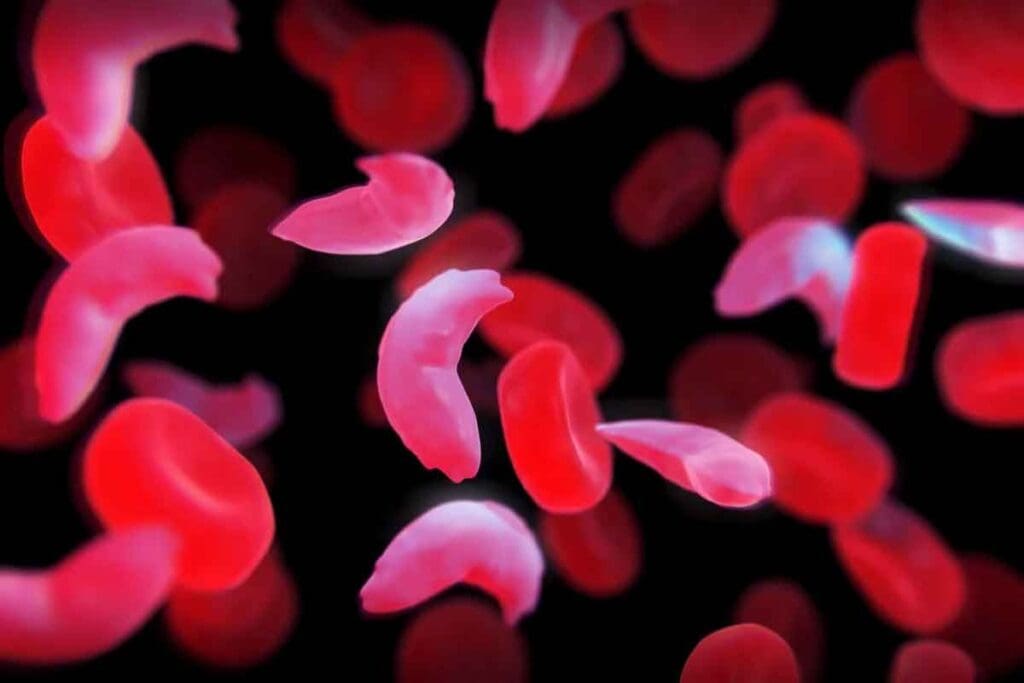Last Updated on November 20, 2025 by Ugurkan Demir

Many people wonder if the sickle cell trait can cause pain or symptoms. At Liv Hospital, we want to clear up the confusion between sickle cell trait and sickle cell disease. We also want to talk about the risks and why knowing your status is important.Find out whether does sickle cell trait cause pain, its common symptoms, and what treatment options exist.
Sickle cell trait happens when someone has one abnormal gene linked to sickle cell disease. People with the trait usually live normal lives. But, in rare cases, they might face complications.
We will look into whether sickle cell trait leads to pain and its symptoms. We aim to give you a full understanding of this condition and its effects.

Sickle cell trait and sickle cell disease are two related but different conditions. They both affect how the body makes hemoglobin. But they have different genetic and health impacts.
To understand the differences, we need to look at the genetics. Sickle cell trait happens when someone has one normal and one sickle cell hemoglobin gene. This makes them a heterozygote. On the other hand, sickle cell disease happens when someone has two sickle hemoglobin genes, one from each parent.
The genetic difference between being a heterozygote (SCT) and a homozygote (sickle cell disease) is key. Heterozygotes have one normal hemoglobin gene that can help balance out the sickle gene. Homozygotes, with two sickle genes, don’t have this balance.
This genetic difference greatly affects how each condition shows up. People with SCT usually don’t have symptoms or have mild ones. But those with sickle cell disease often face serious health problems.
In SCT, the presence of one normal hemoglobin gene keeps red blood cells mostly normal. But, during intense exercise or low oxygen, the sickle hemoglobin can cause red blood cells to sickle.
Even so, the effect on blood cells is usually less severe in SCT than in sickle cell disease. Knowing these differences is important for managing health and making smart choices.

Sickle Cell Trait (SCT) usually doesn’t cause pain, but it can under certain conditions. Most people with SCT live normal lives without health problems. Yet, some situations can lead to complications.
People with SCT usually don’t feel pain or symptoms. Their red blood cells work well, and they don’t have the pain episodes seen in Sickle Cell Disease.
Normal daily activities are not affected by SCT. But extreme conditions can sometimes cause problems.
Pain episodes are rare in SCT but can happen in extreme situations. These include:
These situations can make red blood cells sickle, causing pain. It’s important for SCT carriers to know these risks, like athletes or those doing hard work.
Knowing these triggers helps SCT carriers prevent pain. Drinking enough water during exercise and avoiding too much hard work can help avoid pain episodes.
In summary, SCT usually doesn’t cause pain, but knowing what can trigger it helps manage it better.
Sickle Cell Trait usually doesn’t show symptoms. But some people might have mild signs. Knowing these symptoms is key to staying healthy and knowing when to see a doctor.
People with Sickle Cell Trait might feel some symptoms when they’re very active. These can include:
These symptoms are usually mild and go away with rest and drinking water.
Sickle Cell Trait symptoms are different from those of Sickle Cell Disease. Sickle Cell Disease symptoms are more severe and frequent. They include recurring pain, a higher risk of infections, and other serious problems because of the abnormal hemoglobin.
“People with Sickle Cell Trait are generally healthy, but they may have some risk, particularly with extreme exertion or at high altitudes,” said a medical expert. This shows why it’s important to know the difference between SCT and Sickle Cell Disease.
In summary, Sickle Cell Trait is usually without symptoms. But knowing about the possible mild symptoms, mainly during intense activity, helps people take care of themselves and get medical help when it’s needed.
Many people with Sickle Cell Trait worry if it can turn into Sickle Cell Disease. We’re here to tell you that Sickle Cell Trait (SCT) is a stable genetic condition. It does not change into Sickle Cell Disease (SCD).
The genetic makeup of SCT stays the same from birth to death. People with SCT are born with it, and it doesn’t turn into SCD later. The main difference is in genetics: SCT carriers have one normal and one sickle hemoglobin gene. Those with SCD have two sickle hemoglobin genes.
Key points about the genetic stability of SCT include:
There are many wrong ideas about SCT and its chance of turning into SCD. We’ll clear up these misconceptions to help you feel better.
Misconception 1: SCT can turn into SCD. As we’ve said, SCT is a stable condition and does not turn into SCD. The genetic factors that define SCT are fixed and never change.
Misconception 2: SCT is a mild form of SCD. While both conditions involve the sickle hemoglobin gene, SCT and SCD are different. People with SCT usually don’t have the severe symptoms of SCD.
By understanding SCT’s genetic stability and clearing up common myths, we aim to give you peace of mind. This is for those with Sickle Cell Trait.
It’s important to know how Sickle Cell Trait (SCT) affects anemia in carriers. SCT is different from Sickle Cell Disease but can impact blood health. This includes how much hemoglobin and red blood cells are in the body.
People with SCT usually have normal hemoglobin levels and don’t get anemia. This is because SCT only affects one gene, unlike Sickle Cell Disease, which affects both. Anemia is when there are not enough red cells or hemoglobin in the blood.
Most people with SCT live healthy lives without blood problems. Their red blood cells work well under normal conditions. They don’t get the severe anemia seen in Sickle Cell Disease. Hemoglobin levels are usually normal, showing SCT doesn’t harm red blood cell production or function much.
Even though SCT itself doesn’t usually cause anemia, extreme situations can. For example, intense physical exertion, high altitudes, or severe dehydration can cause problems. These situations might make red blood cells sickle, leading to temporary issues, but not usually anemia.
It’s key for SCT carriers to know these risks and take steps to avoid them. This is important during hard workouts or when traveling to high places. By understanding their condition and taking care, SCT carriers can stay healthy.
To find out if you have sickle cell trait, blood tests are used. These tests look for the sickle hemoglobin gene. Knowing how these tests work is key.
Several blood tests are used to diagnose sickle cell trait. The most common is the hemoglobin electrophoresis. This test separates different hemoglobins in the blood. Other tests include:
Hemoglobin electrophoresis is a major tool for diagnosis. It checks the types of hemoglobin in your blood, like HbA and HbS. The results show that if you have:
| Hemoglobin Type | Normal | Sickle Cell Trait | Sickle Cell Disease |
| HbA | Present | Present | Absent or Reduced |
| HbS | Absent | Present | Present |
It’s important to understand these results. If you’re unsure about your test results, talk to a doctor.
Sickle Cell Trait is usually not a big problem, but there are some risks to know about. We’ll talk about kidney issues and rare but serious problems that can happen under extreme conditions.
People with Sickle Cell Trait might face kidney problems. They could get hematuria, which means blood in the urine. This happens because sickled red blood cells can damage the kidneys and cause bleeding.
Hematuria is a serious sign, but it’s often treatable. It’s key for those with SCT to get regular check-ups for kidney issues.
Even though it’s rare, extreme effort or high altitudes can cause big problems for SCT carriers. These situations might lead to splenic sequestration or exertional rhabdomyolysis, both of which are very dangerous.
“Athletes with Sickle Cell Trait are at a higher risk for exertional death, particularly during intense physical activities.” -Expert Opinion
It’s important for SCT carriers to know these risks and take steps to avoid them. They should avoid too much physical effort and drink plenty of water, mainly when they’re really active.
Knowing about these complications helps SCT carriers manage their condition better. This way, they can lower the chance of serious health problems.
The Sickle Cell Trait (SCT) is found more in some groups than others. This is true, mainly in places where malaria is common.
In Black populations, SCT is more common. This is because of the history of malaria in these areas. In places where malaria was common, SCT helped people survive. This meant more people with SCT could have children, spreading the trait.
A study on NCBI shows SCT is very common in some African countries. It’s found in up to 30% of people, showing how it helped against malaria.
The places where SCT is common match where malaria used to be. In Africa, the Mediterranean, and parts of Asia, SCT is more common. This is because it protects against malaria. This shows how genetics, environment, and disease work together.
“The high frequency of Sickle Cell Trait in malaria-endemic regions is a result of the selective pressure exerted by malaria, making it a classic example of natural selection in humans.” – A geneticist
There’s a clear link between SCT and fighting off malaria. People with SCT get less sick from malaria. This has made SCT more common in places where malaria was a big problem.
Sickle cell trait, often seen as harmless, can be a challenge for athletes in high-intensity sports. Many with SCT live active lives without problems. But intense physical activity can bring specific risks that athletes, coaches, and trainers must know about.
The National Collegiate Athletic Association (NCAA) has set guidelines for SCT in athletes. These guidelines suggest that:
Professional sports also have rules for SCT screening and awareness. Athletes with SCT should get regular health checks and tell their health providers and sports teams about their condition.
Preventing problems is key for athletes with SCT. Some good ways to do this include:
By knowing the risks and using these prevention tips, athletes with SCT can lower their chance of problems. It’s also important for them to work with their health providers to make plans that fit their needs and health.
Planning a family with Sickle Cell Trait means knowing about genetic risks. People with SCT are usually healthy, but can pass the gene to their kids. It’s key to understand SCT’s impact on family planning to make smart choices.
Genetic counseling is a must for SCT carriers planning a family. Counselors explain the risks of passing SCT to kids and the inheritance patterns. They discuss the chances of a child having SCT or Sickle Cell Disease (SCD) based on both parents’ genotypes.
Genetic counseling looks at risk factors and genetic testing options. It helps parents make informed choices about their reproductive health.
SCT follows an autosomal recessive pattern. A child needs one defective gene from each parent to have SCD. If both parents have SCT, each child has a 25% chance of SCD, a 50% chance of SCT, and a 25% chance of neither.
| Parent 1 | Parent 2 | Chance of Child Having SCD | Chance of Child Having SCT | Chance of Child Having Neither |
| SCT | SCT | 25% | 50% | 25% |
| SCT | Normal | 0% | 50% | 50% |
| SCD | SCT | 50% | 50% | 0% |
Knowing these chances is vital for family planning. Genetic counseling offers personalized risk assessments based on parents’ genetic makeup.
Sickle Cell Trait is usually not harmful, but there are things to know for good health. To stay healthy, it’s important to be aware, make lifestyle changes, and talk to doctors.
Telling doctors about Sickle Cell Trait is key. This helps them make better health choices for you. Doctors can help manage SCT and avoid problems.
When you talk to doctors, share your health history and any symptoms. This helps them tailor care just for you.
Changing your lifestyle can greatly improve life with Sickle Cell Trait. Drinking lots of water is key, as dehydration can cause issues. Also, stay away from very hot or cold places and avoid too much hard work.
By making these lifestyle changes and talking to doctors, you can live a healthy and active life with Sickle Cell Trait.
Sickle Cell Trait (SCT) is different from Sickle Cell Disease. It has its own risks and things to consider. Knowing about SCT is key for those who carry it, helping them manage it well.
SCT is usually not harmful but can be risky in certain situations. This includes hard physical work or very harsh weather. Knowing these risks and taking steps to avoid them can help a lot.
Understanding SCT’s genetic side is important, like when planning a family. Getting genetic counseling can help understand the risks of passing SCT or Sickle Cell Disease to children. Also, telling doctors about SCT is important for getting the right care and safety measures.
In short, knowing about SCT helps people live healthy lives and avoid risks. By staying informed and taking action, SCT carriers can keep their condition from affecting their quality. This summary shows how important it is to be aware, manage SCT well, and have the support of healthcare providers.
No, having sickle cell trait is different from having sickle cell disease. Sickle cell trait means you carry the sickle cell gene. Sickle cell disease is when you have two copies of the gene, one from each parent.
Usually, people with sickle cell trait don’t feel pain. But, very hard work or high altitudes might cause pain in some cases.
Most people with sickle cell trait don’t show symptoms. But some might feel muscle cramps or get tired during hard exercise. These symptoms are not as bad as those with sickle cell disease.
No, sickle cell trait can’t turn into sickle cell disease. The genetic makeup of the sickle cell trait stays the same throughout life. It’s not a step towards getting sickle cell disease.
Usually, people with sickle cell trait have normal hemoglobin levels and don’t have anemia. But some conditions might affect red blood cells, leading to anemia in rare cases.
Blood tests, like hemoglobin electrophoresis, diagnose sickle cell trait. These tests show if you carry the sickle cell gene. Knowing your test results is key to understanding if you have sickle cell trait.
Rare complications of sickle cell trait include kidney problems like hematuria. Extreme conditions might cause more serious issues, but these are rare.
Sickle cell trait is common in areas where malaria was once common, like many African countries. It offered protection against malaria, so it spread in these areas over time.
Yes, athletes with sickle cell trait should follow guidelines from sports groups, like the NCAA. These guidelines help prevent problems during training and games. They suggest starting slowly with hard exercise and avoiding extreme conditions.
People with sickle cell trait should talk to genetic counselors when planning a family. Knowing how the sickle cell gene is passed on helps couples understand the risks of passing it to their kids.
Managing sickle cell trait means telling your healthcare providers about it and making lifestyle changes. Most people with the trait live normal lives without big health problems. Knowing your status and taking steps to prevent issues helps keep you healthy.
Subscribe to our e-newsletter to stay informed about the latest innovations in the world of health and exclusive offers!